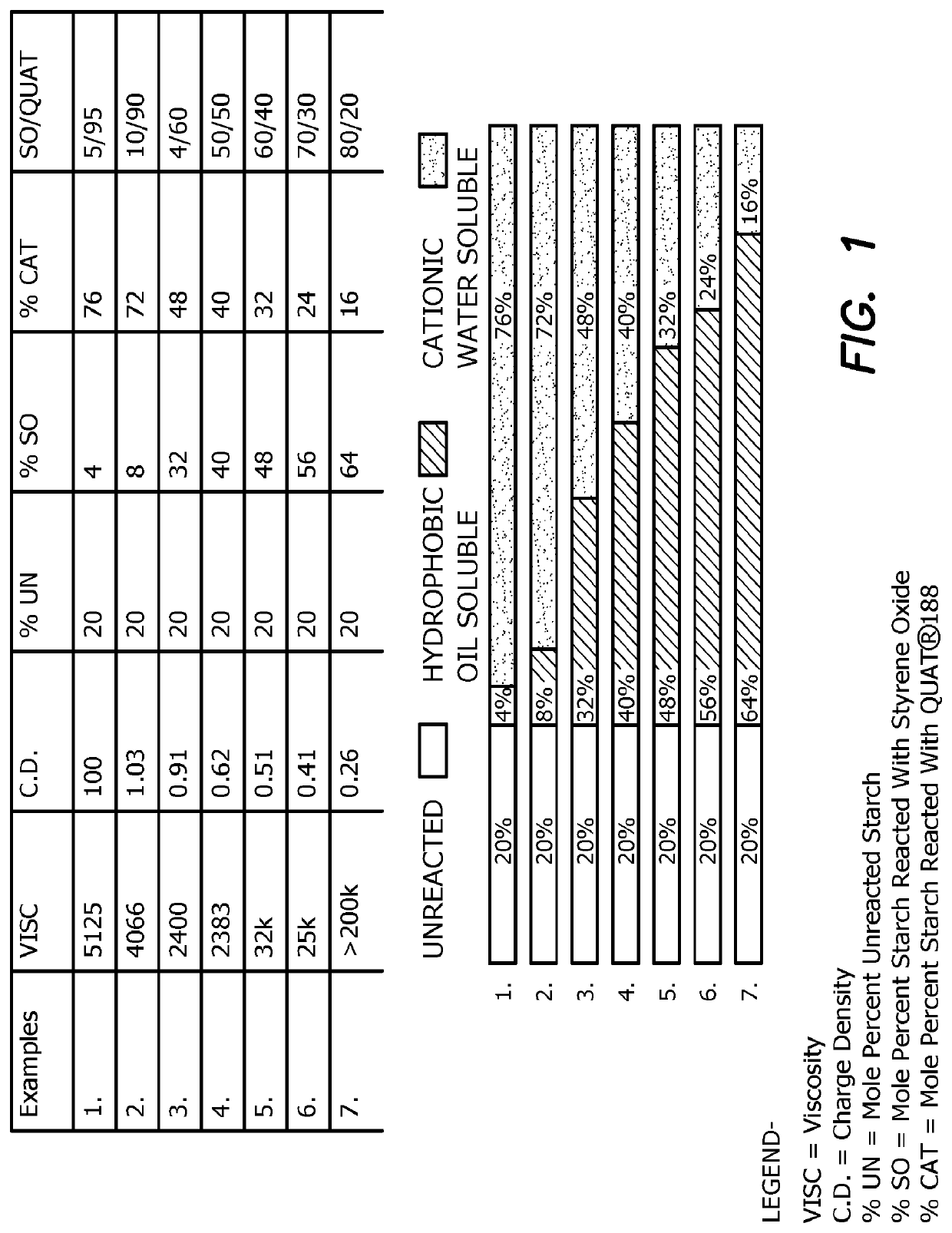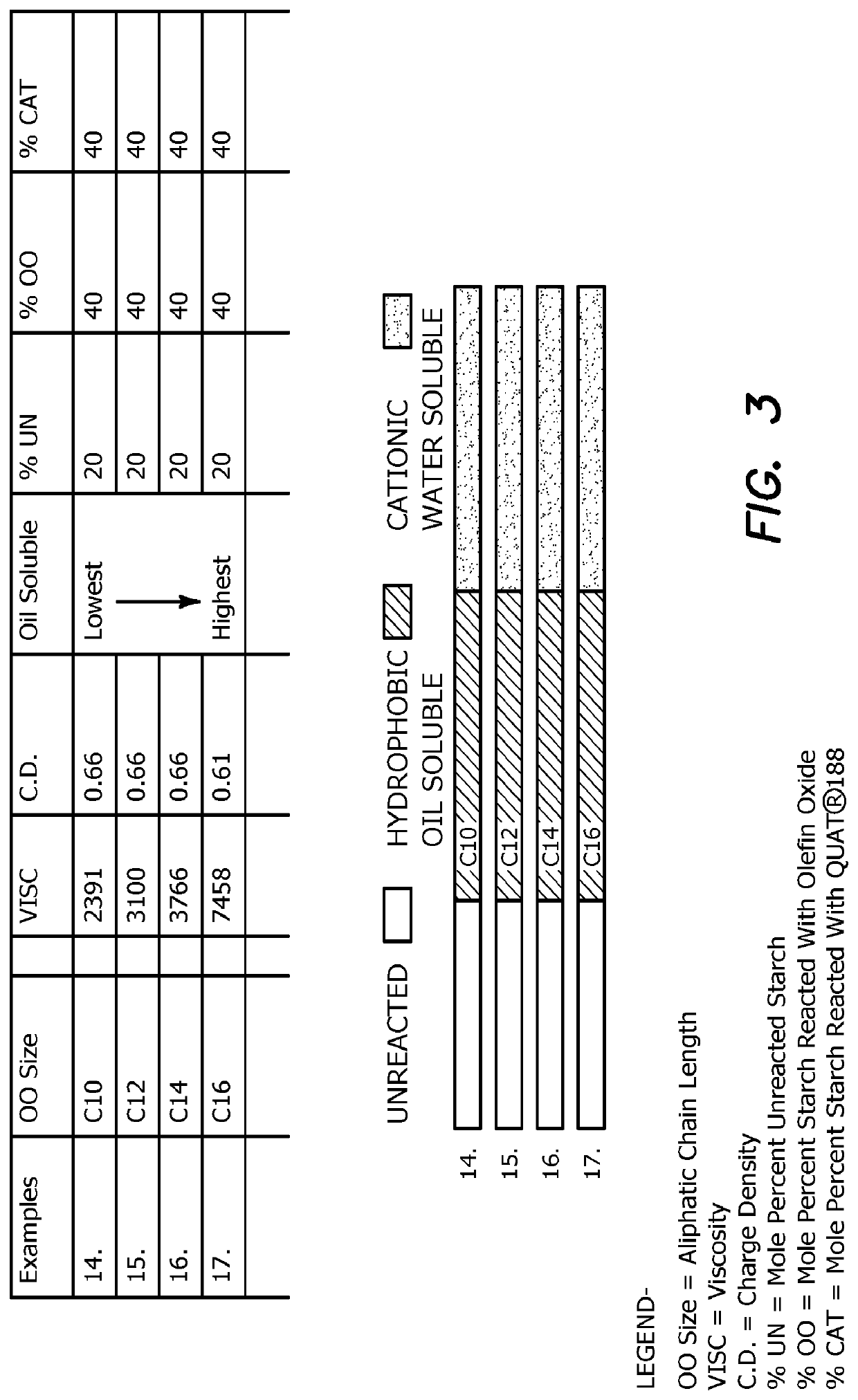Water-Enriching and Water Depleting Compositions and Methods
a composition and water depleting technology, applied in the field of water enriching and water depleting compositions and methods, can solve the problems of reducing the effectiveness of “primary” methods, reducing the efficiency of “primary” methods, and causing the oil to migrate hundreds of kilometers horizontally, so as to reduce the amount of water produced, reduce the salt content of crude oil, and minimize pollution.
- Summary
- Abstract
- Description
- Claims
- Application Information
AI Technical Summary
Benefits of technology
Problems solved by technology
Method used
Image
Examples
examples 1-7
[0096]A panel of 7 samples are made comprising industrial acid modified corn starch (about 25% amylose and about 75% amylopectin) to which styrene oxide and the cationic quaternary ammonium reagent Quat® 188 is conjugated in various amounts, ratios and charge densities. The samples are prepared using a protocol similar to that shown in
EXAMPLE 18.
[0097]FIG. 1 shows the characteristics of each of the seven samples, wherein the viscosity (Visc), charge density (C.D.), mole percent unreacted starch (% UN), mole percent starch reacted with the hydrophobic reagent styrene oxide (% SO), and mole percent starch reacted with the hydrophilic reagent Quat® 188 (% CAT) are shown, as well as the ratio of starch reacted with styrene oxide / starch reacted with Quat® 188 (ratio SO / Quat®).
[0098]Each sample was tested in an emulsion breaking test against aliquots of the same crude oil sample containing water. For the particular sample provided, Example 4, a dewatering composition having a charge densi...
examples 14-17
[0103]In a third panel, a set of samples based on Examples 4 and 9 were altered to substitute aliphatic olefin oxides of increasing chain length (C10, C12, C14 and C16) for styrene oxide to determine the effect on oil solubility and performance of the aliphatic chain length of the hydrophobic component. In some cases it may be useful for the dewatering composition not to contain styrene oxide, which may linger in the environment.
example 18
[0104]81.1 grams of industrial acid modified corn starch (about 25% amylose and about 75% amylopectin) (from Cargill, Inc.) was slurried up in 134 ml of water in a 500 ml flask equipped with a mechanical stirrer and a temperature controller and mixed at room temperature until uniform. 20 grams of 50% sodium hydroxide was then added to the mixture and the temperature was increased to 95° F. and held for one hour.
[0105]18.5 grams of styrene oxide (obtained from Sigma Aldrich Co.) was then added to the mixture which was mixed for an additional 30 minutes. 44.6 grams of Quat® 188 (65% (by weight) solution of 3-chloro-2-hydroxypropyltrimethylammonium chloride from Dow Hampshire Chemical Corp. was then added slowly to the mixture and the temperature was increased to 115° F. and held for 6 hours. The charge density of the mixture was then determined. 52 ml of water was then added and the resulting mixture was neutralized to pH 7.1 with 9.5 grams of concentrated hydrochloric acid.
[0106]The ...
PUM
| Property | Measurement | Unit |
|---|---|---|
| Fraction | aaaaa | aaaaa |
| Fraction | aaaaa | aaaaa |
| Fraction | aaaaa | aaaaa |
Abstract
Description
Claims
Application Information
 Login to View More
Login to View More - R&D
- Intellectual Property
- Life Sciences
- Materials
- Tech Scout
- Unparalleled Data Quality
- Higher Quality Content
- 60% Fewer Hallucinations
Browse by: Latest US Patents, China's latest patents, Technical Efficacy Thesaurus, Application Domain, Technology Topic, Popular Technical Reports.
© 2025 PatSnap. All rights reserved.Legal|Privacy policy|Modern Slavery Act Transparency Statement|Sitemap|About US| Contact US: help@patsnap.com



